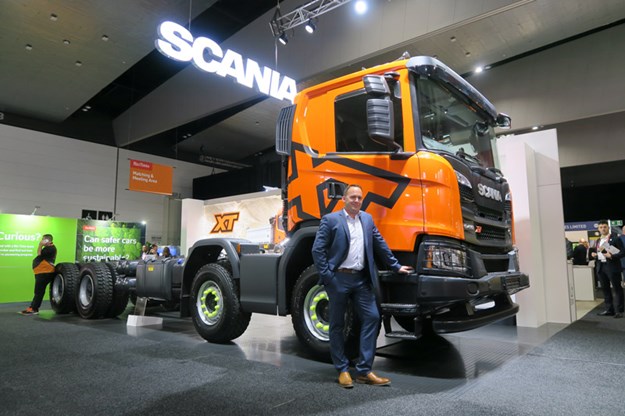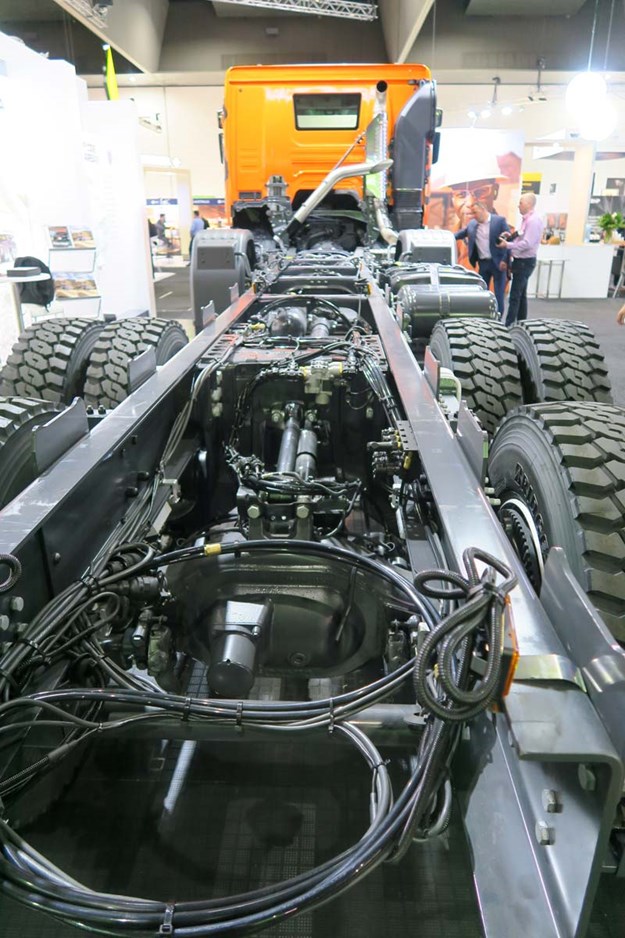Scania’s ‘extra tough’ XT mining and construction range couples on-highway comforts with physical and technical protections
 |
|
The XT is aimed at construction as well as mining applications
|
It is entirely fitting that Scania should grace, if that’s the right word, the International Mining and Resources Conference in Victoria with its new XT bulk haulage tough nut.
Certainly, Melbourne is a world away from the Pilbara but the show coincides with that city’s bid to outdo Sydney as the infrastructure construction capital of the nation, and the XT is primed and aimed at both industries.
And while senior Scania folk at headquarters and locally focus on the New Truck Generation “system”, common safety features – so front-of-mind amongst fleet-owners facing increasing Chain of Responsibility pressures – IT advancements and maintenance services, there is much about the XT not seen on sealed roads.
Its face features a “unique protruding steel front bumper” with 40-tonne towing point in the centre, headlamp protection grilles, solid door mirror housings, front under-bumper skid-plate, elevated ride-height and all-steel parabolic leaf spring suspension.
That said, the badge most certainly will be seen through car windscreens across the country, given money is no object just now in the infrastructure construction game.
 |
|
Scania national account manager – mining and resources Robert Irving at the mining show
|
Show stopper
Scania national account manager – mining and resources, Robert Irving, was on hand at the show, along with visiting Scania Mining sales and marketing solutions engineer, Erik Engholm, to give the low-down on the XT G 410 B8x4HZtwin-steer rigid cab/chassis at the centre of the exhibition space.
As Irving explains, the 40-tonne front end towing capability can be used for separating road train trailers.
“The configurations we can get out of the factory now is everything from a small 4×2 all the way up to a 300-tonne total gross combination prime mover,” he says as we circle the display vehicle.
“We are quoting for a few of these [300-tonne] for a few customers at the moment and we’re looking to have a few of those in far-north Queensland in major haul operations now.”
Scania Australia is busy making a virtue of its local content these days and Irving points to related design aspects.
“Our body-builder interfacing is all tied in behind the cab,” he says.
“So, rather than having control boxes all mounted up and underneath, which allows exposure to weather, high heat, engines and all that, we now allocate DIN pins that sit in behind the cab and say to our body-builders ‘right, the following ones are for you to use’.
“As standard is the seven-inch [178mm] infotainment system that can be tied in with reverse cameras and split screen cameras that run on sites as well, so now again it saves them having to bolt on external monitors and screens around inside the cabs. Again, if you are working in high ambient temperatures and have to start drilling in dashes, things start to crack.”
Despite its rugged pedigree, Irving insists the XT is “only slightly heavier” than the previous iteration, “mainly to the reinforced front end that we will do on these”. That amounts to an extra 500kg over the steer axle, but mostly off-road where it won’t be noticed and that might otherwise be taken up with a bull bar.
The mining show featured a stock truck with 32 tonnes at the back end and twin nines over the steers for a 50-tonne GVM unit.
As much of the drive train and internals are situated below the rails as possible to ease the bodybuilders’ work.
 |
|
Driver’s view of the layout all lit up
|
Vital stats
Available in three cab sizes, the XT comes with safety features available to its highway siblings, such as side curtain rollover airbags as standard in its choice of P, G and R-series Day Cab.
The PGR 17 Day Cab comprises a 540mm fold-down bunk, while the larger PGR 20 cab comes with a standard-sized bunk
The XT is available with a range of Scania’s “frugal and modular” Euro 5 or Euro 6 SCR (selective catalytic reduction) emission engines and Opticruise automated gear-changing, including the clutch-on-demand feature “for particularly challenging environments”.
Engine configurations include five-cylinder nine-litre, six-cylinder 13-litre engines or the V8 16.4-litre.
Scania has switched to the lighter, less complex SCR-only exhaust after-treatment (with the exception of the top-of-the-range, highest-output V8 730hp (544kW) engine, which uses a combination of exhaust gas recirculation and SCR.
“Specific changes to the nine-litre five-cylinder engine include new engine software and a reconfigured combustion chamber,” it says.
“One important change is that oil cooling is now thermostat-controlled. This contributes a 1 per cent fuel saving, since the oil can generally be allowed to maintain a higher working temperature. The cooling fan is fitted directly on the crankshaft and no energy-intensive upshifting is required.
“Other modifications that help to reduce consumption are an increased compression ratio (from 18.0:1 to 19.0:1), a cylinder pressure increased to a maximum of 190 bar (180 bar for the 280hp [209kW] version) and a more efficient combustion chamber.
“The nine-litre family shares its technology and design with its six-cylinder siblings in the 13-litre in all material respects.
“Its balance shafts and the introduction of an asymmetric crank pin pitch counteract the tendency of five-cylinder engines to vibrate, so that it now runs just as smoothly and silently as a six-cylinder engine.”
All Scania’s Euro 6 diesel engines are already certified for a mixture of up to 10 per cent biodiesel in their basic configuration, without any impact on maintenance requirements.
 |
|
Behind the cab, Scania has cleared the decks to allow bodybuilders to do their stuff as easily as possible
|
Drive train
Scania offers a range of steered and fixed axles, of which driven axles are available with and without hub reduction with a selection of gear ratios.
For on-road applications, the front axle can carry up to 12 tonnes for specific low-speed off-road applications, while the twin steer versions allow for 2×12 tonnes for on-site, off-road operation.
The transfer gearbox used for driven front axles has two gears and permanent all-wheel drive is available.
Rear axle choices come with and without hub reduction.
Bogie axles with hub reduction can carry up to 32 tonnes for on-road applications and up to 42 tonnes for on-site operation.
Non-steered tag axles have a 10-tonne capacity, whereas steered tag axles can carry up to nine tonnes.
“The electro-hydraulic rear-steered axle helps to increase load capacity and reduce fuel consumption,” Scania says.
Importance of timing
The range arrives at an auspicious time, just as the mining and resources industry is picking up following the end of the boom earlier in the decade, but it also coincides with the ongoing national infrastructure investment effort.
“The launch of the Scania XT range is a response to the growth of business the company has attracted in recent years in the mining and resources sector in Australia, as well as an answer to operators involved in the current domestic and civil infrastructure construction boom,” the company says.
“The arrival of the XT means Scania is well-placed to service its existing as well as new customers in the mining and construction sectors.”
With owner services remaining one of the more hotly contested aspects of heavy truck competition, the company continues to make a virtue of its offering.
“Scania provides a variety of customer-friendly services designed to support uptime and total operating economy, and the XT range provides customers with the same benefits that long-distance and urban distribution operators enjoy,” it says.
“These include having a nominated fleet manager to support planning, coordination and administration of all fleet services, who will work to detect potential problems in advance, and optimise the vehicle or fleet’s service plan to achieve maximum uptime.
“Scania can also configure a service arrangement where its factory-trained technicians can attend in-house, rented or temporary on-site workshops to maintain or repair vehicles as well as ensure sufficient supplies of spare parts are kept on hand.”
 |
|
The skid plate rises to the 15cm protruding front bumper
|
Technical aspects
That extends to in-cab and in-office IT provision to ensure asset transparency, with the Scania Fleet Management Systems – Control Package providing information on fleet position, vehicle tracking and geofencing, as well as fuel use and driver behaviour, and can capture damage reports to help speed up repairs.
“The Scania XT is perfectly set-up for a range of construction and mining applications on sealed and unsealed surfaces,” Scania Australia MD, Mikael Jansson, says.
“The Scania XT has been designed to shrug off tough conditions and a few bumps and scrapes without the need to visit a workshop to replace exterior fittings.
“Our customers will be happy to gain additional uptime facilitated by this careful attention to detail.
“Trucks like these often cover significant distances each year on regular roads in the course of delivery and back-loading, so efficient fuel use is of great importance to the operator.
“Of course, the Scania XT features all the pertinent safety features and equipment needed to provide the greatest level of safety and safe operation to protect drivers from harm, unnecessary downtime and inconvenience.
“The construction industry faces increasing demands for sustainable and cost-effective production.
“With a powerful line-up ready for the toughest mining and construction tasks, Scania is well prepared to meet the highly diverse transport assignments within these sectors.
“We have the right products, the right services, and the right skills to help Australian mining and construction operators specify the perfect vehicle for their needs, securing maximum uptime and enhanced total operating economy, protecting their profitability, and therefore enhancing their long-term business stability.”
SCANIA XT MINING TRUCK SPECS
Engine: Scania in five-cylinder nine-litre, six-cylinder 12.7-litre, V8 16.4-litre (show version DC13 138 Euro 5)
Power: 308kW (410hp) @ 1,900rpm
Torque: 2,150Nm (1,586 ft-lb) @ 1,000–1,300rpm
Transmission: Opticruise 12-speed + two crawler gears
Drive: 4×4 or 6×6 + other options on request
Emission control type: SCR (V8 is SCR + EGR)
Emission control standard: Euro 5 or 6
KEEP READING


